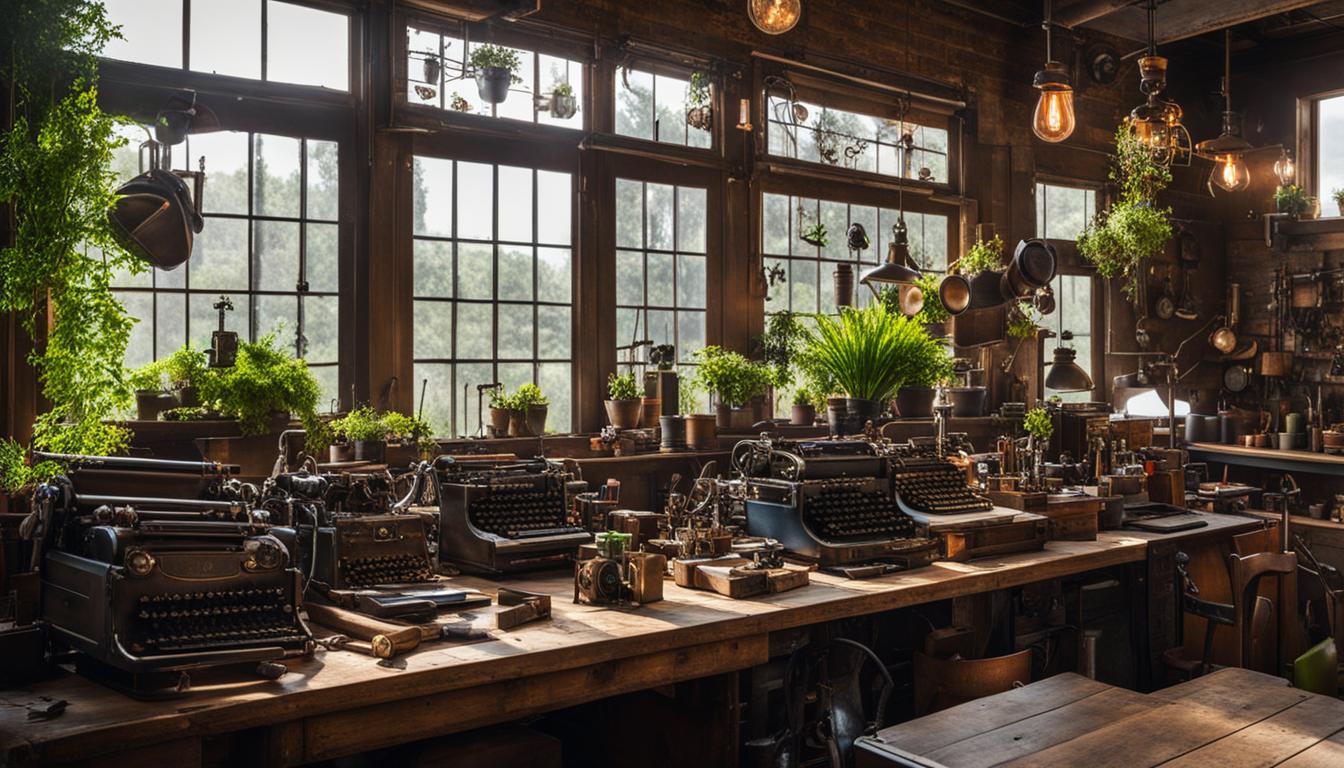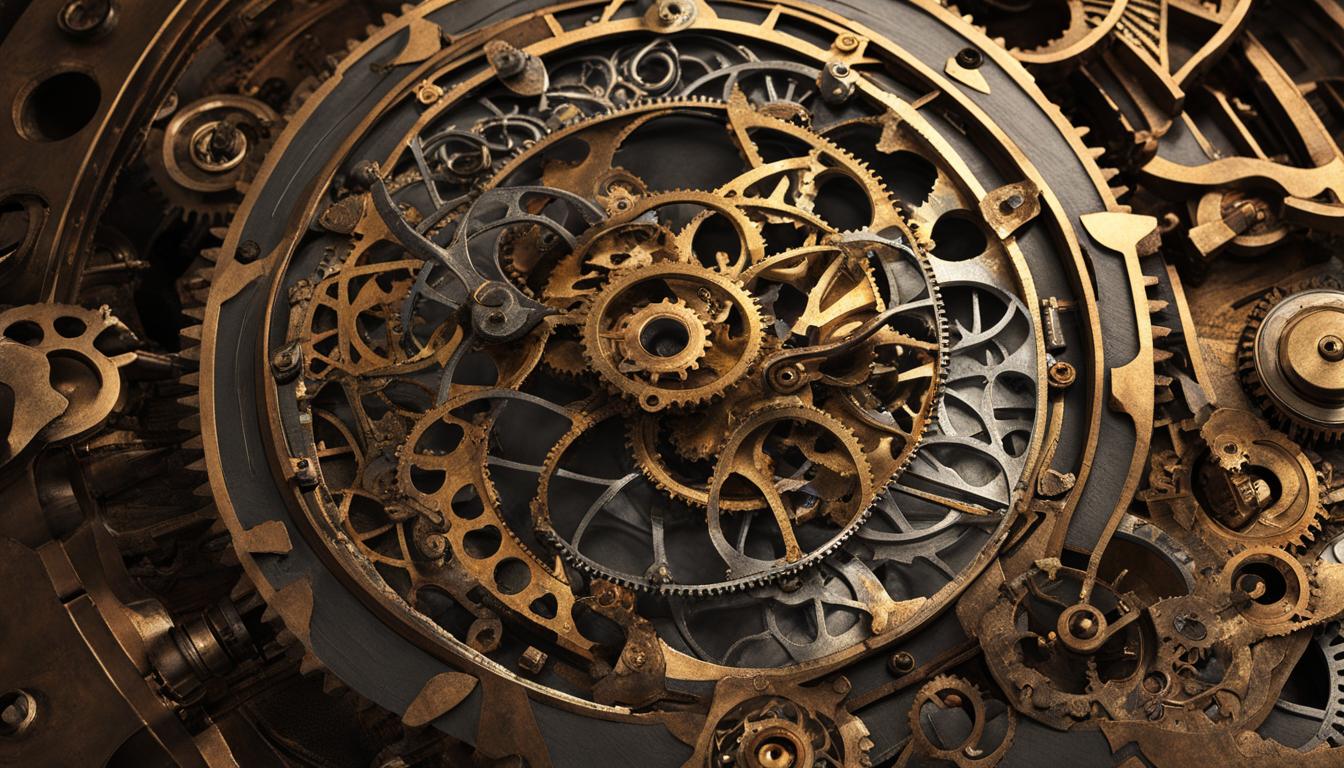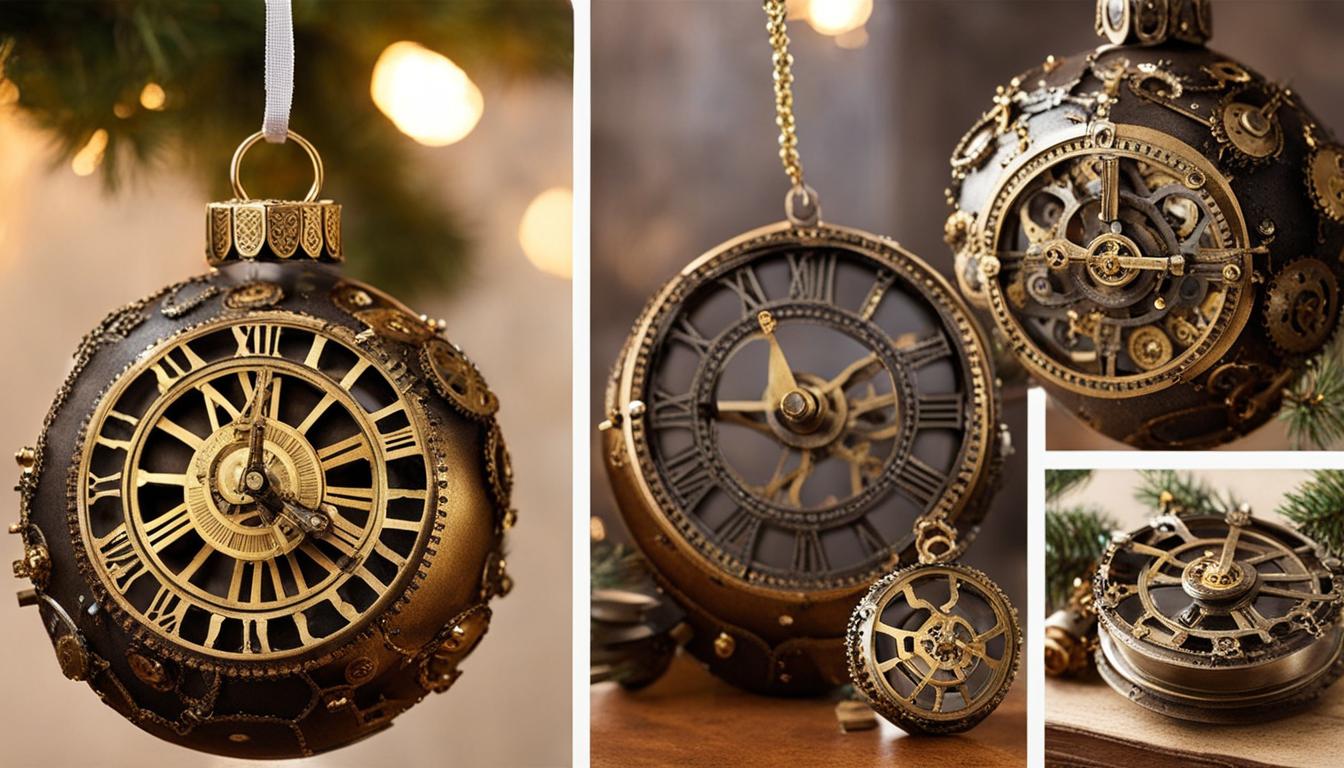The world of steampunk crafting is a fascinating blend of creativity, ingenuity, and a deep commitment to sustainability. Steampunks have embraced eco-friendly practices, utilizing sustainable materials and innovative techniques to create unique and mesmerizing crafts.
Steampunks challenge the norms of the capitalist system by creating and distributing their own self-produced subcultural products. They value sustainability and actively promote eco-friendly steampunk crafting ideas, setting an example for DIY enthusiasts around the world.
Key Takeaways:
- Sustainable steampunk crafting promotes the use of recycled and upcycled materials.
- Steampunk objects are meticulously handcrafted works of art, showcasing the value of craftsmanship.
- Steampunks prioritize the use of sustainable materials, such as salvaged wood and recycled metal.
- By repurposing and reimagining objects, steampunks reduce waste and contribute to a more sustainable world.
- The imaginative approach of steampunk crafting encourages resourcefulness and innovation in reducing waste.
The Intersection of Steampunk and Sustainability
Steampunk crafting embraces sustainability through its ingenious incorporation of recycling and upcycling practices. This unique subculture has mastered the art of repurposing old materials, transforming them into stunning pieces of art. At the core of the steampunk aesthetic lies a deep commitment to reducing waste and creating environmentally friendly crafts.
“Steampunk is all about breathing new life into forgotten objects,” says renowned steampunk artist, Amelia Hart. “We take discarded gears, vintage fabrics, and even broken machinery parts and turn them into something beautiful. It’s a powerful statement against our throwaway culture.”
Steampunk designers often scour thrift stores, flea markets, and salvage yards in search of materials with historical significance. They believe that incorporating these elements adds depth and character to their creations. By giving new purpose to old and neglected items, steampunk crafters showcase their resourcefulness and commitment to sustainability.
Green Steampunk Crafting Techniques
One of the key principles of green steampunk crafting is to minimize waste. Crafters meticulously plan their projects, utilizing materials efficiently and avoiding unnecessary scraps. They find innovative ways to incorporate salvaged elements, such as using gears as decorative accents or repurposing old keys as unique pendants.
Additionally, steampunk crafters often opt for eco-friendly alternatives to traditional adhesives and finishes. They seek out water-based, non-toxic options that have minimal impact on the environment. By embracing these techniques, steampunk artisans demonstrate that sustainability and creativity go hand in hand.
Environmentally Friendly Steampunk Crafts
Steampunk crafting lends itself naturally to environmentally friendly practices. The use of reclaimed and repurposed materials not only reduces waste but also ensures that each creation is truly one-of-a-kind. Steampunk enthusiasts take pride in owning unique pieces that have a story and a purpose.
Furthermore, the focus on handcrafted artistry in steampunk allows for a slower, more thoughtful approach to consumption. Rather than mass-producing items, steampunk artisans invest time and care into each piece. This intentional approach promotes sustainability by encouraging individuals to value quality over quantity.
In conclusion, the intersection of steampunk and sustainability showcases the power of creativity in promoting environmental consciousness. Steampunk crafters demonstrate that recycling, upcycling, and utilizing sustainable materials can lead to breathtaking artistic creations. By embracing green crafting techniques and choosing environmentally friendly practices, steampunk enthusiasts contribute to a more sustainable future.
Sustainable Materials in Steampunk DIY
Steampunk DIY enthusiasts have a strong commitment to sustainability, and this is evident in the materials they choose for their projects. By prioritizing upcycling and repurposing, they give new life to old materials, reducing waste and minimizing their environmental impact. When it comes to sustainable steampunk design principles, the focus is on finding materials that can be reused or transformed into something new and unique.
Salvaged wood is a popular choice among steampunk crafters. They source discarded or reclaimed wood from various places and use it to create stunning furniture, sculptures, and decorative items. Not only does this promote sustainability by reducing the need for new materials, but it also adds a touch of history and character to the final piece. Vintage fabrics, often sourced from second-hand stores or family heirlooms, are another favorite among steampunks. These fabrics are given a new purpose and transformed into clothing, accessories, and home decor items that capture the essence of the steampunk aesthetic.
Reclaimed metal, such as old gears, pipes, and machinery parts, is also widely used in steampunk crafting. These materials are repurposed to create intricate and unique designs, showcasing the resourcefulness of steampunk enthusiasts. The combination of different metals and textures adds depth and visual interest to the final product. By embracing sustainable materials in their projects, steampunk DIYers demonstrate their commitment to reducing waste and making eco-friendly choices.
| Materials | Benefits |
|---|---|
| Salvaged Wood | – Reduces the need for new materials – Adds character and history to the final piece |
| Vintage Fabrics | – Repurposes existing materials – Captures the essence of the steampunk aesthetic |
| Reclaimed Metal | – Utilizes discarded materials – Creates unique and intricate designs |
In conclusion, steampunk DIY enthusiasts have a strong focus on sustainability and strive to minimize their environmental impact through their crafting practices. By sourcing sustainable materials such as salvaged wood, vintage fabrics, and reclaimed metal, they transform old and forgotten items into new and unique creations. The use of these materials not only reduces waste but also adds character and history to their projects. Steampunk crafting demonstrates that eco-friendly choices can be both artistic and sustainable.
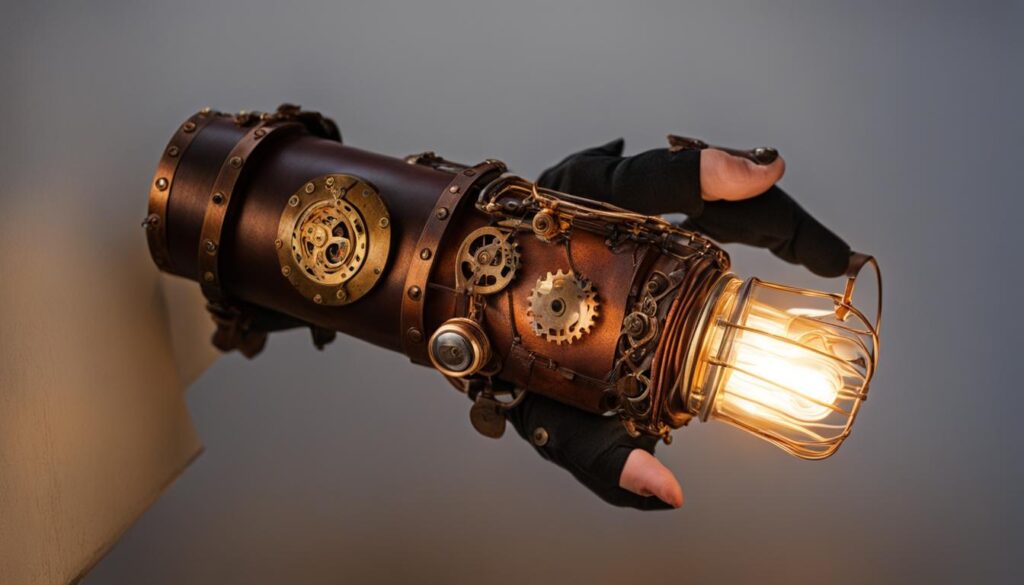
Sustainable Steampunk Crafting: The Beauty of Handcrafted Objects
Steampunk crafting is more than just a hobby; it’s an artistic movement that values craftsmanship and creativity. Within the steampunk community, there is a sense of artistic camaraderie as like-minded individuals come together to create meticulously handcrafted objects. These unique pieces showcase the dedication and passion of steampunks, while also embodying eco-conscious crafting practices.
“Steampunk objects are not mere crafts; they are works of art,” says renowned steampunk artist, Emily Wright. “We invest time and effort into each piece, allowing it to tell a story and capture the essence of an alternate era.”
By focusing on handcrafted techniques, steampunks embrace sustainability and promote a more eco-friendly approach to crafting. Rather than relying on mass-produced items, they opt for repurposed materials that would otherwise be discarded. Through their inventive use of salvaged wood, recycled metal, and vintage fabrics, steampunks breathe new life into old objects and reduce waste.
Not only do handcrafted steampunk objects have an aesthetic appeal, but they also serve as symbols of the community’s commitment to sustainable practices. Each item tells a story, blending Victorian aesthetics with futuristic elements, creating a visual representation of the steampunk ethos. These objects serve as reminders that sustainable crafting can be both beautiful and meaningful.
| Key Elements of Eco-conscious Steampunk Crafting | Benefits |
|---|---|
| Collaborative craftsmanship | Promotes artistic camaraderie and encourages resource sharing |
| Use of recycled and repurposed materials | Reduces waste and minimizes environmental impact |
| Handcrafted techniques | Emphasizes craftsmanship and adds a personal touch to each piece |
| Unique designs | Allows for individual expression and creativity |
The beauty of handcrafted steampunk objects lies in their intricate details, imaginative designs, and the eco-conscious mindset behind their creation. These objects stand as a testament to the ingenuity and resourcefulness of the steampunk community, inspiring others to embrace sustainability in their own crafting endeavors.
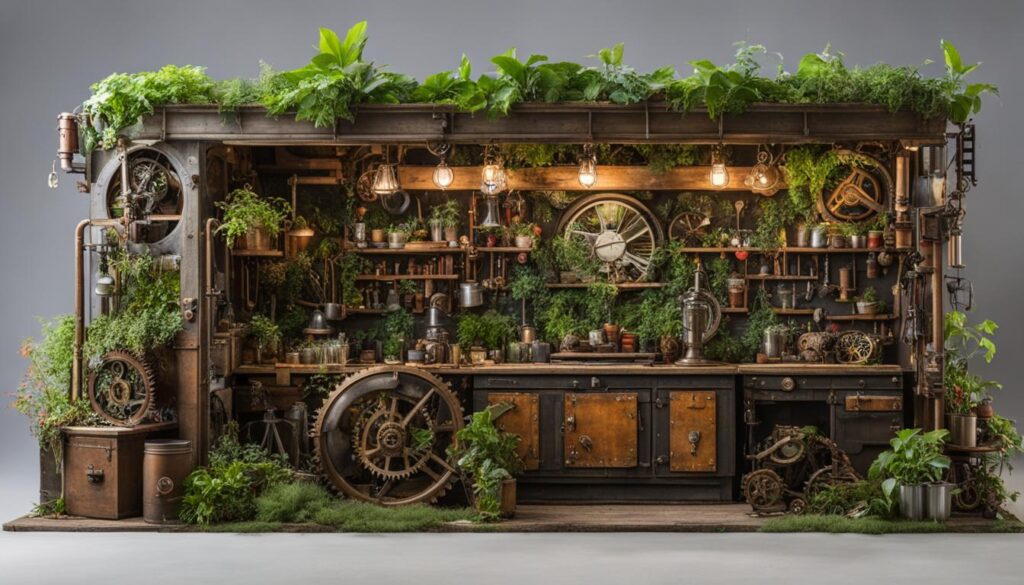
Unleashing Creativity through Sustainable Steampunk Crafting
Steampunk crafting not only challenges conventional crafting methods but also provides a platform for artists to explore their creativity. By combining recycled materials, vintage aesthetics, and futuristic elements, steampunks create art that reflects their unique vision.
“Sustainable steampunk crafting is a way to unleash creativity and push the boundaries of traditional art forms,” says renowned steampunk designer, Victoria Yates. “By incorporating sustainable principles into our work, we can create something extraordinary while making a positive impact on the environment.”
With their eco-conscious mindset, steampunks push the limits of their imagination and find innovative ways to repurpose materials. This imaginative approach to sustainability not only results in visually stunning objects but also challenges the status quo of consumerism and showcases the power of artistic expression.
Steampunk’s Imaginative Approach to Sustainability
Steampunk enthusiasts have a unique and imaginative approach to sustainability, finding clever ways to repurpose and reimagine objects. By breathing new life into old materials, they contribute to the reduction of waste in the crafting process. Steampunk DIY projects often involve modifying existing objects or combining unexpected elements to create something entirely new and original.
Steampunks embrace resourcefulness and innovative thinking when it comes to crafting, prioritizing sustainability in their creative endeavors. They understand the importance of reducing waste and strive to find eco-friendly solutions in their steampunk projects. From salvaging old gears and reclaimed wood to repurposing vintage fabrics, steampunks showcase their commitment to environmental consciousness and make a positive impact on the planet.
With their imaginative and sustainable approaches to DIY, steampunks inspire others to think creatively and consider the environmental impact of their own crafting practices. By adopting the principles of repurposing and reimagining, crafters can reduce waste, minimize their carbon footprint, and contribute to a more sustainable future.
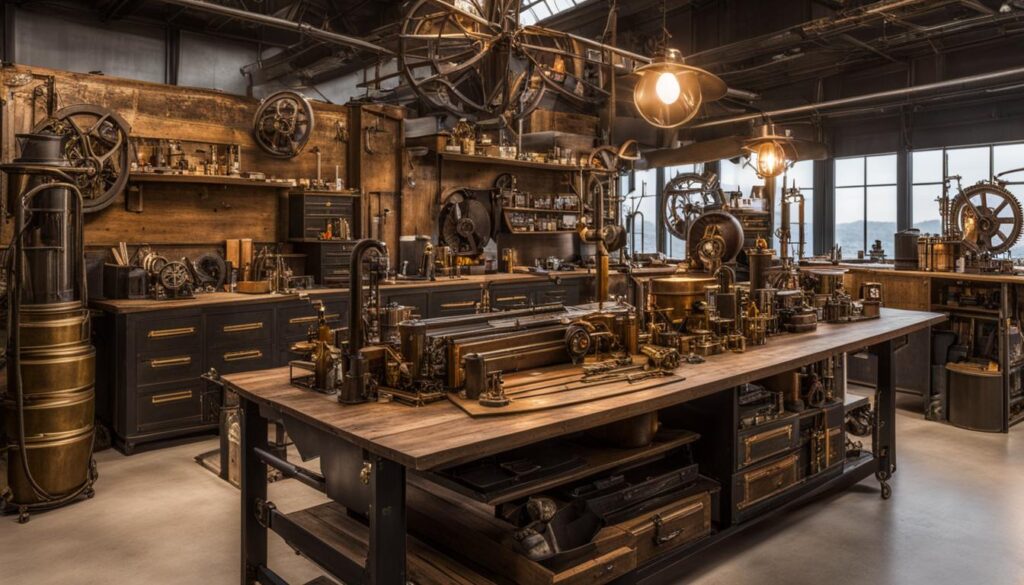
Table: Examples of Sustainable Approaches in Steampunk DIY
| Approach | Description |
|---|---|
| Upcycling | Taking discarded objects and transforming them into new, higher-value products. |
| Using salvaged materials | Finding and repurposing old gears, vintage fabrics, and reclaimed wood. |
| Combining unexpected elements | Mixing disparate objects to create unique and imaginative steampunk crafts. |
| Repurposing unwanted items | Taking objects that would otherwise go to waste and giving them new purpose and function. |
| Reducing single-use materials | Avoiding the use of non-recyclable or non-biodegradable materials. |
The examples listed in the table showcase the variety of sustainable approaches that steampunk DIY enthusiasts embrace. By incorporating these techniques into their projects, they not only contribute to reducing waste but also create unique and visually stunning crafts that make a positive impact on the environment.
Conclusion
The world of steampunk crafting offers a captivating and sustainable way to express creativity. Steampunks have mastered the art of incorporating eco-friendly practices into their DIY projects, making sustainable steampunk crafting a unique and admirable endeavor. Through the use of recycling, upcycling, and sustainable materials, steampunks showcase their commitment to reducing waste and making a positive impact on the environment.
What sets steampunk crafting apart is not only its commitment to sustainability, but also the undeniable beauty and craftsmanship of the handcrafted objects it produces. Each piece is meticulously created, with intricate details and unique designs that make them stand out in the world of DIY crafting. By investing time and effort into each creation, steampunks emphasize the value of eco-conscious practices and the importance of preserving the artistic process.
Steampunk’s imaginative approach to sustainability is truly inspiring. By repurposing and reimagining old materials, steampunks breathe new life into forgotten objects, reducing waste in the process. Through their resourcefulness and innovative techniques, they encourage DIY enthusiasts to think outside the box and find creative ways to make a difference. Eco-friendly steampunk crafting ideas continue to captivate and inspire those who strive to make a positive impact on the environment.
In conclusion, steampunk crafting embodies the perfect fusion of creativity and sustainability. By embracing green steampunk crafting techniques, steampunks showcase their commitment to eco-friendly practices and leave a lasting impression on the DIY community. With its mysterious allure and captivating designs, sustainable steampunk crafting is an art form that continues to push boundaries and inspire individuals to think differently about their impact on the environment.
Frequently Asked Questions (FAQ)
What materials are commonly used in steampunk crafting?
Steampunk crafting often incorporates recycled and upcycled materials such as old gears, vintage fabrics, and discarded machinery parts.
How do steampunks contribute to sustainability?
Steampunks embrace sustainable practices by repurposing and transforming old materials into unique pieces of art, reducing waste and promoting eco-friendly crafting.
What is upcycling, and how does it relate to steampunk crafting?
Upcycling is the process of transforming discarded items into new and often higher-value products. Steampunk crafters commonly upcycle materials like salvaged wood, recycled metal, and vintage fabrics to create their unique creations.
Why is handcrafting important in the steampunk community?
Handcrafted steampunk objects showcase the value of craftsmanship and foster a sense of artistic camaraderie among steampunks. The intricate details and unique designs of these objects make them stand out in the DIY crafting world.
How do steampunks find creative ways to reduce waste in their crafting?
Steampunks repurpose and reimagine objects in innovative ways, breathing new life into old materials and reducing waste in the process. This imaginative approach to sustainability encourages resourcefulness and promotes eco-conscious practices.
What makes steampunk crafting sustainable and eco-friendly?
Steampunk crafting incorporates recycling, upcycling, and the use of sustainable materials. By embracing these practices, steampunks showcase their commitment to reducing waste and making a positive impact on the environment.
Source Links
- https://beyondvictoriana.com/2016/02/07/steampunkhands-on-crafting-a-subcultural-lifestyle-objects-and-the-search-for-home-in-steampunk-part-1/
- https://medium.com/@kirsten_26251/steampunk-a-romantic-revolution-de0e6853e548
- https://ecofriend.org/amazing-steampunk-creations-made-with-recycled-materials/

